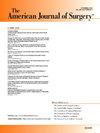利用电子病历工具改善医疗服务提供者对修改后脑损伤指南的遵守情况
IF 2.7
3区 医学
Q1 SURGERY
引用次数: 0
摘要
方法为创伤团队和放射科开发了智能语句,并于 2022 年 12 月实施。对 2021 年 3 月至 2023 年 7 月期间符合 mBIG 纳入标准的创伤性脑损伤 (TBI) 患者进行了复查。比较了干预前后智能口令的使用情况和 mBIG 的临床依从性(以重复头部成像、入住 ICU 和神经外科会诊的减少百分比来衡量)。干预后,mBIG1 患者的神经外科会诊次数明显减少(82.4 % vs. 50.0 %,OR = 0.21,p = 0.03),而 mBIG2 患者的重复头部 CT(91.0 % vs. 66.7 %,OR = 0.2,p = 0.01)、入住 ICU(66.7 % vs. 38.5 %,OR = 0.31,p = 0.02)和神经外科会诊(93.9 % vs. 56.4 %,OR = 0.08,p <0.01)。结论标准化智能短语可以简化工作流程,显著提高创伤团队对创伤性脑损伤最佳实践指南的依从性,减少不必要的成像、会诊和昂贵的 ICU 入院。本文章由计算机程序翻译,如有差异,请以英文原文为准。
Leveraging an EHR tool to improve provider adherence to the modified brain injury guidelines
Introduction
The aim was to leverage electronic health record (EHR) smartphrases to improve compliance with the modified Brain Injury Guidelines (mBIG).
Methods
Smartphrases were developed for the trauma team and radiology and implemented December 2022. Traumatic brain injury (TBI) patients meeting mBIG inclusion from 03/2021- 07/2023 were reviewed. Smartphrase usage and clinical compliance with mBIG (measured by percent reduction of repeat head imaging, ICU admissions, and neurosurgery consults) were compared pre- and post-intervention.
Results
268 cases were examined. Post-intervention, mBIG1 patients had significantly fewer neurosurgery consults (82.4 % vs. 50.0 %, OR = 0.21, p = 0.03), while mBIG2 patients had significantly fewer repeat head CTs (91.0 % vs. 66.7 %, OR = 0.2, p = 0.01), ICU admissions (66.7 % vs. 38.5 %, OR = 0.31, p = 0.02) and neurosurgery consults (93.9 % vs. 56.4 %, OR = 0.08, p < 0.01).
Conclusion
Standardized smartphrases can streamline workflow and significantly improve trauma team compliance with best practice guidelines for TBI and reduce unnecessary imaging, consults, and costly ICU admissions.
求助全文
通过发布文献求助,成功后即可免费获取论文全文。
去求助
来源期刊
CiteScore
5.00
自引率
6.70%
发文量
570
审稿时长
56 days
期刊介绍:
The American Journal of Surgery® is a peer-reviewed journal designed for the general surgeon who performs abdominal, cancer, vascular, head and neck, breast, colorectal, and other forms of surgery. AJS is the official journal of 7 major surgical societies* and publishes their official papers as well as independently submitted clinical studies, editorials, reviews, brief reports, correspondence and book reviews.

 求助内容:
求助内容: 应助结果提醒方式:
应助结果提醒方式:


